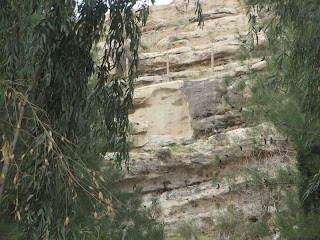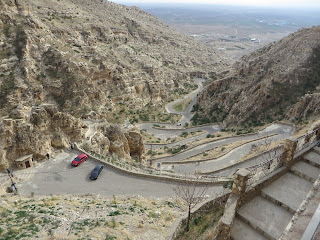Road to Duhok, Iraqi Kurdistan
We left Amedi at dawn as we had a lot to see during the days long drive. We drove up into the mountains with the intention of seeing Saddam Hussein's summer palace. It is located on the top of Garan Mountain. We had checked with our fixer and were told that the road was passable even for our truck, Marianna. He had been up a week before but it had snowed just a few days since his trip.There was a pile of rocks across the road, but had been been warned about that. There were tyre markd where other people had driven over the blockage in their 4x4s. There was no road sign to say that the road was shut and it was ominous that there had been no traffic, either overtaking us or coming towards us. No matter, our fixer had said it was ope so we continued.
Looking back t the hairpins and just to the left is the pile of rocks across the road.
Snow on the montain sides.
Just one of many potholes that we had to negotiate.
Looking back down the mountain. We had got above the snow line and had crossed several snowdrifts across the road. Eventually we got to an icy patch that stretched right across the road and up the road to at least the next hairpin. We tried but we couldn't go any further and had to turn back.
Looking back t the hairpins and just to the left is the pile of rocks across the road.
Snow on the montain sides.
Just one of many potholes that we had to negotiate.
Looking back down the mountain. We had got above the snow line and had crossed several snowdrifts across the road. Eventually we got to an icy patch that stretched right across the road and up the road to at least the next hairpin. We tried but we couldn't go any further and had to turn back.
Easier said than done on a narrow, icy steep mountain road. Martin had to reverse down until he found a bend with enough space to turn the truck around. We ll got out and watched from a safe distance, just in case the side of the road collapsed taking the truck with it. On a normal round, Marianna could do a three point turn. On this mountain road, it took a lot more work. At times the back end of the truck was hanging over the edge of a vertical drop. Every manouvre took the front of the truck another metre down the road.
Eventually the truck was facing downhill. We walked down the roaad to reboard. We had make a great effort to see Saddam Hussrin's palace but th mountain had beaten us. We now had to make a large detour to get back on track but at least the rods in the valley bottom were a lot smoother and we could make up time.
Looking along the valley.
...a covered passageway...Eventually the truck was facing downhill. We walked down the roaad to reboard. We had make a great effort to see Saddam Hussrin's palace but th mountain had beaten us. We now had to make a large detour to get back on track but at least the rods in the valley bottom were a lot smoother and we could make up time.
Looking along the valley.
Our next stop was at the Lalish Temple. This is the most holy place for the Yazidis. The temple is 4,000 yeras old but the faith is over 7,000 years old. There are an estimated 700,000 follower. Over time it has incorporated elements of Judaism, Christianity, Islam Zoastarianism and Sufi believes. The main entrance pathway to the shrine complex. It is considered as holy as Jerusalem and Mecca but it is open to non-believers.
The main passageway through the complex.
Views of some of the shrines and other buildings within the comlex. It is so holy that you have to remove your shoes to walk around. It is not ery comfortable on bare feet on cold stone with flurries of snow every now and again. We were the only visitors and there were just two believers and some security personnel.
There were many carvings but no signs of explanation for visitors and no guides. We were left to wander where we pleased.
A stone arch over a passageway.
Pne of several ribbed cones.
More carvings.
an archway...
...more carvings, presumably of a sun...
The main passageway through the complex.
Views of some of the shrines and other buildings within the comlex. It is so holy that you have to remove your shoes to walk around. It is not ery comfortable on bare feet on cold stone with flurries of snow every now and again. We were the only visitors and there were just two believers and some security personnel.
There were many carvings but no signs of explanation for visitors and no guides. We were left to wander where we pleased.
A stone arch over a passageway.
Pne of several ribbed cones.
More carvings.
an archway...
...more carvings, presumably of a sun...
...another doorway...
...more carvings but no explanation of the significance....
...one of the few other living things on site...
...cute...
...but they have very sharp teeth and although cuddly to look at, they will bite!
A flare from an oil well and processing plant just down the valley.
Next stop was th Khinnis Reliefs. These are Assyrian carvings assocu=iated with a major canal project. They date from 690 BC and the carvings and the canal were created by King Senncherib (ruled 705 - 681 BC). The canal brought water from the river to Nineveh. One of te relifs.
A couple of manmade features, thought to be where grapes were pressed and the juice collected to make wine.Next stop was th Khinnis Reliefs. These are Assyrian carvings assocu=iated with a major canal project. They date from 690 BC and the carvings and the canal were created by King Senncherib (ruled 705 - 681 BC). The canal brought water from the river to Nineveh. One of te relifs.
A view up the river from whch water was diverted into the canal.
Tombs cut into the cliff.
The start of the cnal, with the cliff face cut into a vertical wall to the left and a wall to the right.
Another view of the wall that formed one side of the canal.
...and another carving but it is only just discernable with the aid of the guide and some imagination...
...and this is what the carving might have looked like, taken from another statue in the museum in Baghdad and receated in concrete at the entrance to the site.
The entrance to the site with its recreated statues of a winged cow with a human head.
We had made good time despite the need for a large detour so we could take in another site, the Rabban Hormizd Monastery. One of the structures...
...and more buildings to the left.
The truck couldn't make it up all of the hairpins, so it dropped us off and had to reverse down to a corner to turn around and park facing downhill ready for departure.
Another view of the road up to the manoastery.
The entrance.
The car park at the top of the road, and from there, there are dozens of steps, partly shown bottom right , to reach the churches, cells and library of the manastery. It was built in 640 AD. It was the official residence of the patriarchs of the Eliya line of the Assyrian Church of the East from 1551 to the 18th century. After the union with Rome in the 19th century, it become a prominent monastery of the Chalean Catholic Church. No pictures were allowed inside but there are four churches, the cell and tomb of Rabban Hormizd and the patriarchs.
And then is was an hours drive to Dulok and our hotel for the night. We arrived in plenty of time but had to drive around the city as being a big vehicle, we were banned from using certain roads, an unexpected hindrance and one that we had not been made aware of despite giving our local fixer photos and dimensions of the truck and our arrival time and intended route.












































No comments:
Post a Comment